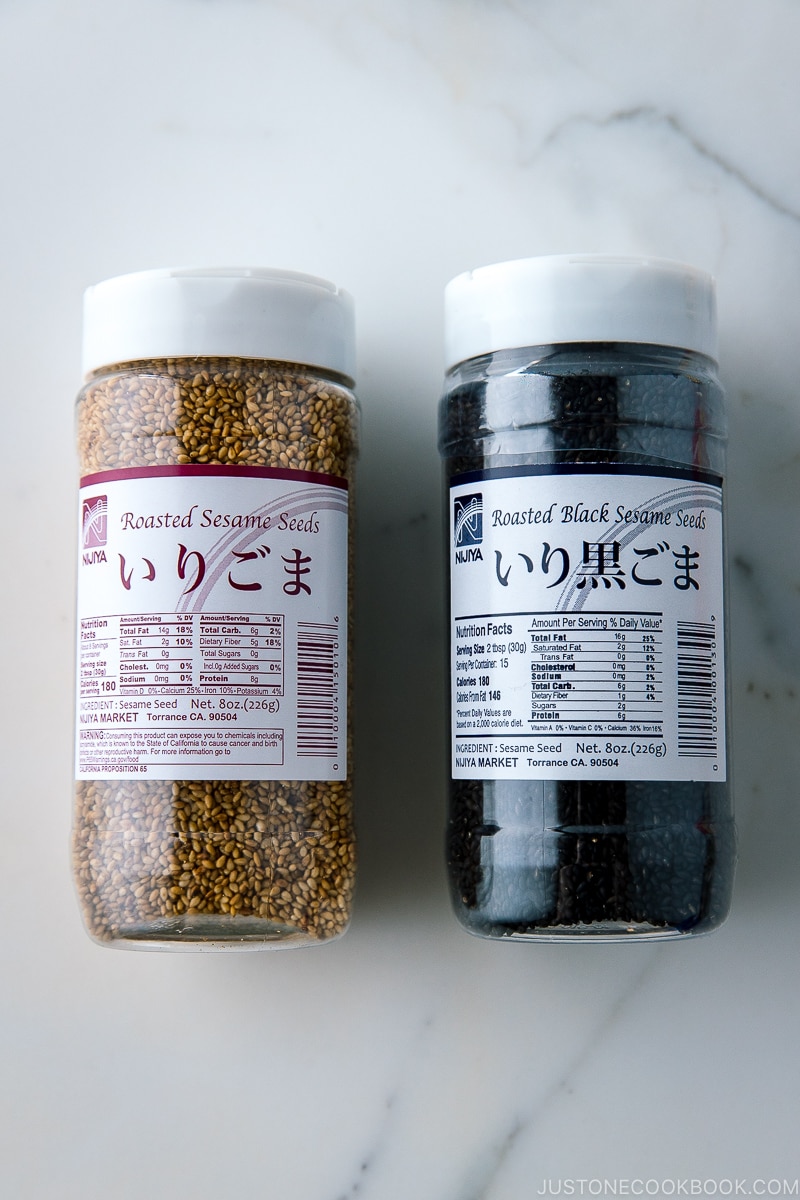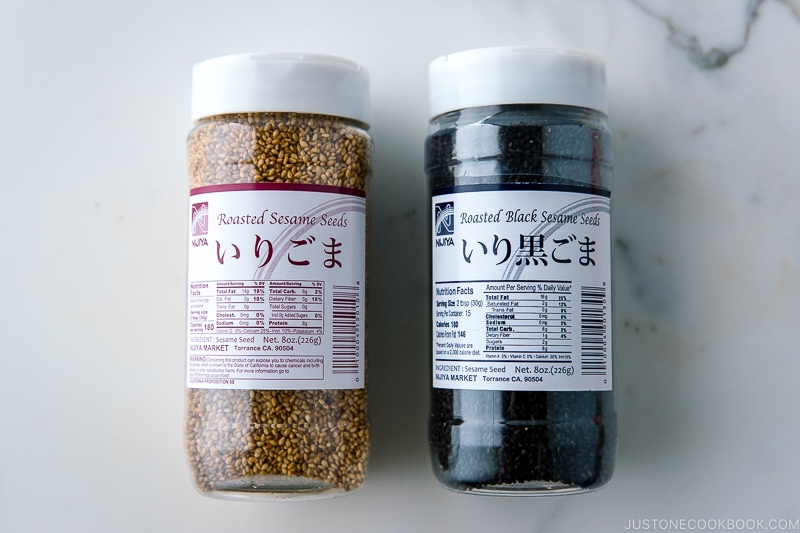Sesame seeds are edible seeds of the sesame plant and add a pleasant, savory, nutty flavor and color to your dish. It’s a nutrient-rich ingredient used throughout the world.

Sesame seeds (胡麻・ごま) are considered to be the oldest oilseed crop known to humanity. In addition to eating the whole seed, it’s also pressed into oil for sesame oil. The Japanese use white and black sesame and whole and crushed seeds in the cuisine.
Table of contents
What Are Sesame Seeds
Sesame seeds are tiny, flat, oval-shaped seeds that grow in pods on the sesame plant (Sesamum indicum), native to parts of Africa and India. The Chinese have harvested sesame seeds for over 5,000 years, and records exist of Ancient Egyptians and Romans using the plant for culinary and medicinal use.
These seeds are commonly used in cooking and baking in many global cuisines, including Mediterranean, Middle Eastern, Asian, and African dishes. You may be familiar with it in hummus, tahini, and sprinkled on top of burger buns.
The Japanese use whole and ground seeds in their cuisine as a garnish, in a paste for vegetable dressing, in baked goods, and shokupan.
Sesame is a common allergen, so allergic people should avoid all sesame products.
1 Tbsp sesame seeds = 8-9 grams.
What Do They Taste Like
It has a nutty, earthy, and slightly sweet flavor.
Variety of Sesame Seeds
There are two types:
- White Sesame Seeds: Creamy white or light beige, used in baking and for garnishing dishes.
- Black Sesame Seeds: Darker in color, ranging from charcoal gray to black. They have a stronger, more robust flavor than white sesame seeds and are used in sweet and savory dishes.
How To Toast
If the seeds are not roasted (you will notice that they don’t have a toasty color), you can toast them in a frying pan (without oil) over medium-low heat. It’ll bring out the aroma and nuttiness. Gently stir occasionally for two to three minutes or until the seeds turn light brown, glisten, and occasionally pop. It can burn quickly, so keep an eye on the pan.
You can also toast toasted seeds to bring out the aroma and flavor.

How To Use
In Japanese cuisine, they are used in a wide range of culinary applications, including sprinkling on salads, rice bowls and noodle dishes, stir-fries, and baked goods, as well as in producing neri goma and cooking oil.
Where To Buy
Find it at Japanese and Asian grocery stores and regular supermarkets.
How To Store
Keep them in a cool, dark place away from sunlight and heat sources. Store them in an airtight container or a resealable bag with minimal air to prevent moisture and contaminants.
Refrigeration or freezing can extend shelf life, especially in warm climates. Check for freshness by smelling and tasting before use. Proper storage helps maintain their quality for several months to over a year.
Health Benefits
The seeds offer a range of health benefits due to their rich nutritional content, which includes healthy fats, protein, vitamins, minerals, and antioxidants.
- Heart Health: Contains monounsaturated and polyunsaturated fats, which are heart-healthy fats that may help reduce the risk of cardiovascular diseases. They also contain phytosterols, which can lower cholesterol levels.
- Antioxidant Properties: Rich in antioxidants, including vitamin E, which can help protect cells from oxidative damage caused by free radicals.
- Bone Health: A good source of calcium, phosphorus, and magnesium, essential for maintaining strong and healthy bones.
- Rich in Protein: Provides a source of plant-based protein, making them valuable for vegetarians and vegans as a protein option.
- Digestive Health: Can support healthy digestion and regular bowel movements, reducing the risk of constipation.
- Mineral Content: Rich in minerals like iron and zinc, which are essential for various bodily functions, including the formation of red blood cells and immune system support.
- Anti-Inflammatory Effects: Have demonstrated anti-inflammatory properties, potentially aiding in managing inflammatory conditions.
- Blood Sugar Regulation: May help stabilize blood sugar levels due to their fiber content and potential effects on insulin sensitivity.
- Skin Health: Sesame seeds’ zinc and vitamin E can contribute to healthy skin by promoting cell repair and protecting against UV damage.
- Immune Support: The vitamins and minerals, particularly zinc and copper, play a role in immune system function.
- Possible Cancer Protection: Some studies suggest that sesamin and sesamol, compounds in sesame seeds, may have anticancer properties.
Recipes Using Sesame Seeds
- Japanese Spinach Salad with Sesame Dressing (Gomaae) 胡麻和え
- Pork Shabu Shabu and Cold Somen with Sesame Miso Sauce 豚しゃぶ冷やしそうめん味噌胡麻だれ
- Sesame Miso Hot Pot 胡麻味噌鍋
- Black Sesame Milk Bread (Shokupan) 黒ごま食パン
- Black Sesame Cookies 黒胡麻クッキー
Wish to learn more about Japanese cooking? Sign up for our free newsletter to receive cooking tips & recipe updates! And stay in touch with me on Facebook, Pinterest, YouTube, and Instagram.